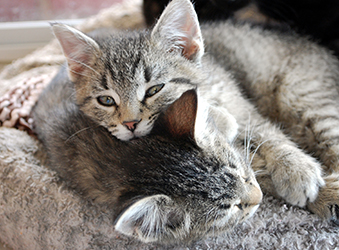posted
on Wednesday, May 14, 2025
in
Pet Help
 Introducing your new cat to your other pets at home can be a tricky process. However, it is one of the most important things to do correctly with your cat or kitten. Here are some hints to ease the change.
Introducing your new cat to your other pets at home can be a tricky process. However, it is one of the most important things to do correctly with your cat or kitten. Here are some hints to ease the change.
Keep them separated
Take your new cat into your home in a cat carrier. Immediately confine the newcomer to one room with food, water, a litter box and a bed.
Keep the cat separated in their own room for a period of time — even up to a week or more. The biggest mistake people make in building the relationship with their resident cats and a newcomer is they immediately let the newcomer roam through the house. Patience is key in this process to building a lasting relationship between the cats. Go in and visit your new cat, play with them, pet them, feed them, and make them feel that this is now home. Remember that your new cat is confused and frightened (how much they show it is different among cats), and you need to reassure them that all is well in their life. Leaving a TV or radio on is a good way to give your cat some background noise.
Start a scent exchange
During the time your cat is separated from your other cats, take a towel and rub it on your new cat - kind of like the cat is wet and you're trying to dry them off. Then take that same towel and rub it on the resident cat(s). Leave the towel in your living room or around the house where your resident cats hang out. What you are doing is taking the scent of your new cat and putting it on the resident ones. Take a second towel and do the same, only backwards, rubbing it first on your resident cats and then the newcomer. Leave that towel in the room with your new cat.
Scent is absolutely critical to getting cats used to each other. By doing this exercise every day, you are getting their scent onto each other. When they meet face to face, they all smell like something they are used to. You can escalate the process by taking a small bit of cooking vanilla and dabbing it on the base of their tails, where they can’t lick. It cements the scent process, making them smell the same. Do this every other day.
Swap the cats' spaces
After a time, allow the cats to explore each other's spaces - still without face-to-face contact. Take the newcomer and place them in the rest of the house, and put your resident cat in the room where you had sequestered the new cat. The newcomer can then explore their new surroundings and spread their scent around the house. This allows both animals to become used to the scent of the other before actual face-to-face contact. This process may take a few hours or a few days, depending on how the cats react. Start with a couple hours and then switch back. The next day, do a couple more hours.
Starting interactions
After a few days of this separation, towels, and switching the cats’ living areas, it is time for an introduction. Only do this when you are going to be home, and do not leave the cats out together unsupervised for a period of time after the initial introduction. Open the door to the sequestered room, and allow the cat to come out on their own time. Let them explore, and allow the cats to meet each other on their own terms.
One good time for face-to-face introductions is at mealtime, if you feed at a set time of the day. They will be so busy eating that they won’t have time for fighting. Be sure to give each cat their own bowl on opposite sides of the room. Make it a special dinner with great smelling food.
Avoid forcing a meeting between your cats. That may cause unnecessary fighting. Let them get acquainted gradually to help develop a positive relationship and lessen the chance of territorial issues.
Expect hissing, spitting, and growling. Don’t interfere unless an actual fight breaks out. If this happens, throw a blanket over each cat and confine them to different quarters. Keep them separated until they have calmed down. Then start over.
Remember rewards
One good way to build a good relationship with the cats is to reward them when they are in the same room or same proximity and behaving appropriately. They don’t need to love each other from day one, but they do need to be able to be in the same room together without warfare. If they are OK with each other, give them treats, and praise them in a soft voice. If they are playful, you also can take a wand or fishing pole toy and play with them together as this will be a fun activity for both of them.